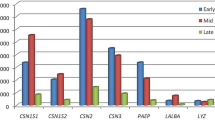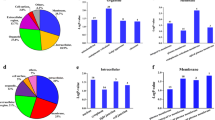Abstract
Xanthosine is hypothesized to increase stem cell number by promoting symmetrical cell division. Stem cells, in particular mammary stem/progenitor cells are important for gland growth and tissue repair. Molecular mechanism of xanthosine effects on mammary tissue is very limited therefore, a detailed study is warranted. The objective of this study was to evaluate transcriptomic changes in mammary gland infused/not infused with xanthosine of lactating goat. Seven primiparous Beetal goats on day 5 after kidding, were selected for the study. One gland of each goat was infused with xanthosine (TRT gland) twice daily for 3 days while the other gland did not receive any xanthosine and served as control (CON gland). Biopsy of mammary tissues was taken from TRT and CON glands, 2 days after the last day of treatment that is on day 10 after kidding. Illumina RNA-sequencing (RNA-seq) was performed for global gene expression analysis of contralateral glands. Of 382 differentially expressed genes (DEGs), 372 genes were annotated to the goat genome. Gene ontology analyses revealed majority of the DEGs to be associated with metabolic pathways (glycan and lipid metabolism), biosynthesis of antibiotics and peroxisome proliferator-activated receptor signalling pathways. These molecular pathways are either directly or indirectly involved with lipid metabolism in mammary tissue and host adaptive immune response. Expression of stem cell marker namely aldehyde dehydrogenase enzymes (ALDH1A1, ALDH3B1) were upregulated in the treatment gland. Real-time quantitative PCR (RT-qPCR) analyses of selected DEGs showed their expression profiles to be in agreement with results of RNA-seq. To our knowledge, this is the first study that describes effects of xanthosine on transcriptomic changes of mammary tissue. This information can be used further to dissect the molecular mechanisms underlying effects of xanthosine to improve production potential and udder health.



Similar content being viewed by others
References
Sherley JL, Pare JF (2013) Ex vivo expansion of human adult pancreatic cells with properties of distributed stem cells by suppression of asymmetric cell kinetics. J Stem Cell Res Ther 03:149. https://doi.org/10.4172/2157-7633.1000149
Murrell W, Palmero E, Bianco J et al (2013) Expansion of multipotent stem cells from the adult human brain. PLoS ONE 8:e71334. https://doi.org/10.1371/journal.pone.0071334
Fang L, Shao-hong C, Qing-bo L et al (2010) Rapid proliferation of bone marrow mesenchymal stem cells enhanced by xanthosine. Chin J Pathophysiol 26:2389–2393. https://doi.org/10.3969/J.ISSN.1000-4718.2010.12.020
Choudhary RK, Capuco AV (2012) In vitro expansion of the mammary stem/progenitor cell population by xanthosine treatment. BMC Cell Biol 13:14. https://doi.org/10.1186/1471-2121-13-14
Capuco AV, Evock-Clover CM, Minuti A, Wood DL (2009) In vivo expansion of the mammary stem/progenitor cell population by xanthosine infusion. Exp Biol Med 234:475–482. https://doi.org/10.3181/0811-RM-320
Rambhatla L, Bohn SA, Stadler PB et al (2001) Cellular senescence: ex vivo p53-dependent asymmetric cell kinetics. J Biomed Biotech 1:28–37
Lee H-S, Crane GG, Merok JR et al (2003) Clonal expansion of adult rat hepatic stem cell lines by suppression of asymmetric cell kinetics (SACK). Biotechnol Bioeng 83:760–771. https://doi.org/10.1002/bit.10727
Rauner G, Barash I (2014) Xanthosine administration does not affect the proportion of epithelial stem cells in bovine mammary tissue, but has a latent negative effect on cell proliferation. Exp Cell Res 328:186–196. https://doi.org/10.1016/j.yexcr.2014.06.017
Paten AM, Duncan EJ, Pain SJ et al (2015) Functional development of the adult ovine mammary gland–insights from gene expression profiling. BMC Genom 16:748. https://doi.org/10.1186/s12864-015-1947-9
Suárez-Vega A, Gutiérrez-Gil B, Klopp C et al (2016) Comprehensive RNA-Seq profiling to evaluate lactating sheep mammary gland transcriptome. Sci Data 3:160051. https://doi.org/10.1038/sdata.2016.51
Kumar P, Tan Y, Cahan P (2017) Understanding development and stem cells using single cell-based analyses of gene expression. Development 144:17–32. https://doi.org/10.1242/dev.133058
Colacino JA, McDermott SP, Sartor MA et al (2016) Transcriptomic profiling of curcumin-treated human breast stem cells identifies a role for stearoyl-coa desaturase in breast cancer prevention. Breast Cancer Res Treat 158:29–41. https://doi.org/10.1007/s10549-016-3854-4
Suárez-Vega A, Gutiérrez-Gil B, Klopp C et al (2017) Variant discovery in the sheep milk transcriptome using RNA sequencing. BMC Genom 18:1–13. https://doi.org/10.1186/s12864-017-3581-1
Baldassarre H, Deslauriers J, Neveu N, Bordignon V (2011) Detection of endoplasmic reticulum stress markers and production enhancement treatments in transgenic goats expressing recombinant human butyrylcholinesterase. Transgenic Res 20:1265–1272. https://doi.org/10.1007/s11248-011-9493-y
Choudhary S, Choudhary RK (2017) Rapid and efficient method of total RNA isolation from milk fat for transcriptome analysis of mammary gland. Proc Natl Acad Sci India Sect B Biol Sci. https://doi.org/10.1007/s40011-017-0955-8
Dobin A, Davis CA, Schlesinger F et al (2013) STAR: ultrafast universal RNA-seq aligner. Bioinformatics 29:15–21. https://doi.org/10.1093/bioinformatics/bts635
Trapnell C, Hendrickson DG, Sauvageau M et al (2013) Differential analysis of gene regulation at transcript resolution with RNA-sEq. Nat Biotechnol 31:46–53. https://doi.org/10.1038/nbt.2450
Huang DW, Sherman BT, Lempicki RA (2009) Systematic and integrative analysis of large gene lists using DAVID bioinformatics resources. Nat Protoc 4:44–57. https://doi.org/10.1038/nprot.2008.211
Szklarczyk D, Franceschini A, Wyder S et al (2015) STRING v10: protein-protein interaction networks, integrated over the tree of life. Nucl Acids Res 43:D447-52. https://doi.org/10.1093/nar/gku1003
Crisà A, Ferrè F, Chillemi G, Moioli B (2016) RNA-Sequencing for profiling goat milk transcriptome in colostrum and mature milk. BMC Vet Res 12:264. https://doi.org/10.1186/s12917-016-0881-7
Yohe TT, Tucker HLM, Parsons CLM et al (2016) Short communication: Initial evidence supporting existence of potential rumen epidermal stem and progenitor cells. J Dairy Sci 99:7654–7660. https://doi.org/10.3168/jds.2016-10880
Livak KJ, Schmittgen TD (2001) Analysis of relative gene expression data using real-time quantitative PCR and the 2(-∆∆C(T)) method. Methods 25:402–408. https://doi.org/10.1006/meth.2001.1262
Cui X, Hou Y, Yang S et al (2014) Transcriptional profiling of mammary gland in Holstein cows with extremely different milk protein and fat percentage using RNA sequencing. BMC Genom 15:226. https://doi.org/10.1186/1471-2164-15-226
Wickramasinghe S, Rincon G, Islas-Trejo A, Medrano JF (2012) Transcriptional profiling of bovine milk using RNA sequencing. BMC Genom 13:45. https://doi.org/10.1186/1471-2164-13-45
Shi H, Luo J, Zhu J et al (2013) PPAR γ regulates genes involved in triacylglycerol synthesis and secretion in mammary gland epithelial cells of dairy goats. PPAR Res. https://doi.org/10.1155/2013/310948
Chen S, He H, Liu X (2017) Tissue expression profiles and transcriptional regulation of elongase of very long chain fatty acid 6 in bovine mammary epithelial cells. PLoS ONE 12:e0175777. https://doi.org/10.1371/journal.pone.0175777
Acknowledgements
This study was supported by the grant received from the Department of Biotechnology, Govt. of India, New Delhi, Grant # BT/PR8352/AAQ/1/549/2014.
Author information
Authors and Affiliations
Corresponding author
Ethics declarations
Conflict of interest
Authors declare no competing interests in publishing this article.
Ethical approval
The use of goats for this study was approved by the Committee for the Purpose of Control and Supervision of Experiments on Animals (Reference No. 25/20/2016-CPCSEA), Ministry of Environment, Forest and Climate Change (Animal Welfare Division), New Delhi.
Electronic supplementary material
Below is the link to the electronic supplementary material.
11033_2018_4196_MOESM1_ESM.xlsx
Supplementary material 1. Supplementary file S1: List of differentially expressed genes (DEGs) in goat mammary gland infused with xanthosine solution during early lactation period. (XLSX 34 KB)
11033_2018_4196_MOESM2_ESM.xlsx
Supplementary material 2. Supplementary file S2: Gene Ontology (GO) and KEGG pathway of DEGs in goat mammary gland after xanthosine infusion. All enriched biological processes were ranked from top to bottom according to the false discovery rate (FDR <0.05) for each GO term. Absolute numbers of observed genes and their official gene symbol is provided. (XLSX 19 KB)
Rights and permissions
About this article
Cite this article
Choudhary, R.K., Choudhary, S. & Verma, R. In vivo response of xanthosine on mammary gene expression of lactating Beetal goat. Mol Biol Rep 45, 581–590 (2018). https://doi.org/10.1007/s11033-018-4196-6
Received:
Accepted:
Published:
Issue Date:
DOI: https://doi.org/10.1007/s11033-018-4196-6




